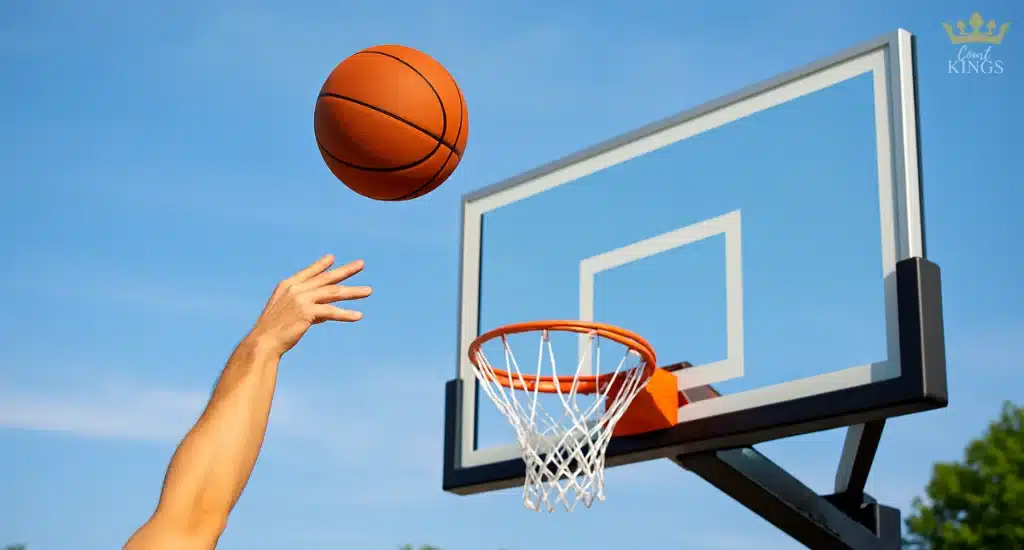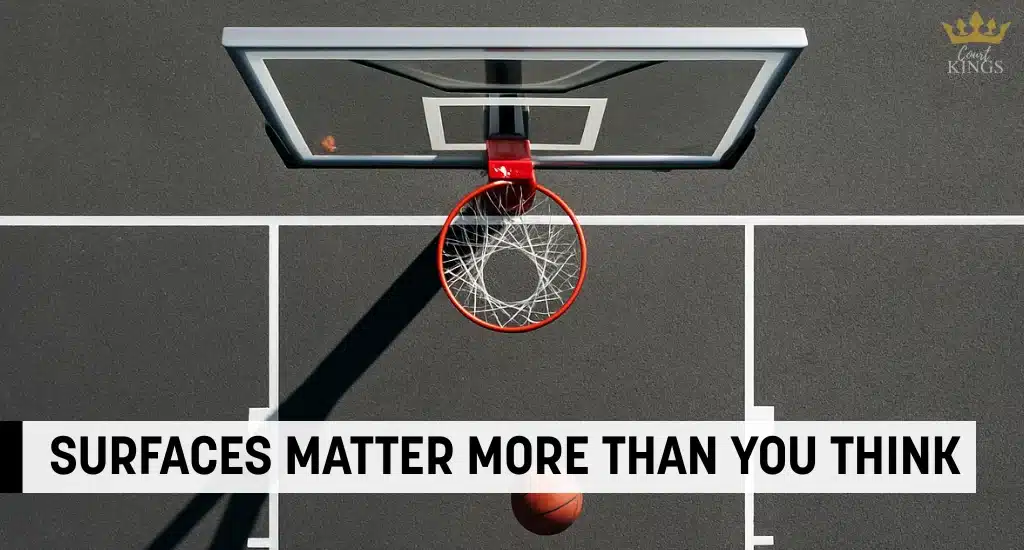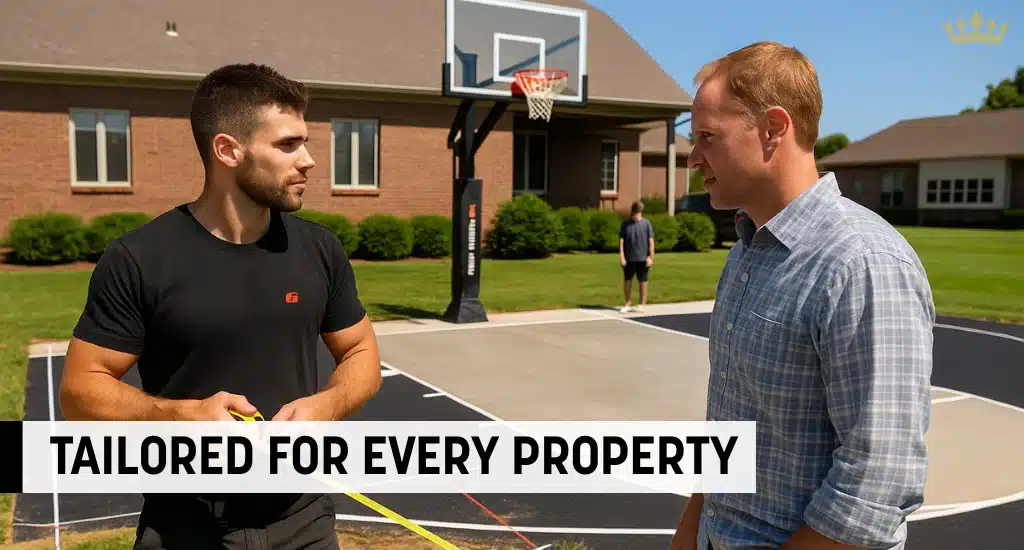

When it comes to building a basketball court that delivers true performance, every detail matters. For homeowners who play regularly or have children in competitive pathways, choosing the right backboard and surface is not a cosmetic decision.
These two elements directly affect how the game feels, how the body responds to movement and how long the court will remain safe and reliable.
While casual setups may use low-cost materials, serious players require equipment that mirrors the conditions of professional courts. Backboards made from tempered glass provide accurate ball rebound and clear visibility.
The court surface itself influences movement mechanics, joint loading and grip control. These are not just preferences. They are factors that influence player development, injury risk and long-term playability.
This article will explore how backboard materials and surface choices affect physical performance, ball response and structural longevity. For families investing in a court that can grow with them, understanding these differences is essential.
The backboard is not just a support for the hoop. It plays a direct role in how the ball rebounds, how shots feel and how players interact with the system.
In biomechanics and sports engineering, the term rebound performance refers to the elasticity of the surface and its ability to return energy to the ball. For basketball players, this influences timing, shooting accuracy and muscle memory.
Backboards also contribute to visual tracking. A clear, stable backboard helps players line up shots and read the ball’s movement off the glass. Poor-quality materials can warp, shake or obscure visibility, especially during fast-paced play.
Court Kings installs professional-grade tempered glass systems for this reason. These are the same materials used in indoor gyms and competitive environments. Below is a breakdown of common backboard materials and how they compare in key areas.
| Material | Rebound Accuracy | Visual Clarity | Vibration Control | Durability (Outdoor) | Suitability for Competitive Play |
| Tempered Glass | Excellent – true rebound identical to indoor gyms | Clear – does not discolour over time | High – minimal shake due to rigid mounting | Highly – weather-resistant and scratch-resistant | Yes – preferred for serious players |
| Acrylic | Moderate – softer response, less energy return | Clear initially – prone to yellowing in sunlight | Low – more vibration on impact | Medium – scratches easily and weakens over time | No – suitable only for casual or light recreational use |
| Polycarbonate | Poor – softest surface, absorbs energy significantly | Cloudy – not fully transparent and discolours quickly | Low – bounces with each shot, especially on banked shots | Low – prone to cracking and UV damage | No – not recommended for consistent or high-level play |

Tempered glass provides a consistent rebound, which supports shooting mechanics and player development. When the ball hits the glass, the energy is returned predictably, allowing players to develop muscle memory over time.
From a safety and durability standpoint, tempered glass is also heat-treated to be stronger than regular glass. If it were to break under extreme force, it would atter into blunt fragments rather than sharp shards, reducing injury risk.
For families with children playing in school leagues or pursuing basketball seriously, installing a tempered glass system at home provides an environment that reflects what they will experience in competition.

The playing surface under a basketball hoop is more than a base. It determines how athletes move, absorb force and maintain stability.
From a sports science perspective, surface quality affects ground reaction forces, which play a key role in both performance and injury risk.
Basketball requires rapid acceleration, deceleration and changes of direction. These movements generate repetitive loading through the feet, ankles, knees and hips.
Surfaces that are too rigid or uneven can lead to discomfort and increase the risk of overuse injuries such as patellar tendinopathy or plantar fasciitis. On the other hand, surfaces with controlled shock absorption reduce joint strain and promote sustainable play.
For homeowners, choosing the right surface involves balancing grip, shock absorption, drainage and long-term durability.
Court Kings offers professional advice to match each surface type with the user’s needs and environment. Below is a comparison of the most commonly used surfaces for residential courts.
| Surface Type | Ball Bounce Quality | Shock Absorption | Traction & Grip | Weather Resistance | Maintenance Level | Lifespan |
| Concrete (Polished) | High – consistent and true | Low – hard surface, minimal give | Good – stable underfoot | High – minimal damage from rain or UV | Low – occasional cleaning only | 25+ years |
| Asphalt | Moderate – some variability over time | Medium – slightly more forgiving than concrete | Moderate – surface may degrade over time | Medium – cracks more easily in changing temperatures | Moderate – sealing required every few years | 10–15 years |
| Modular Tile Systems | Moderate to High – slightly cushioned | High – designed for joint protection | Excellent – slip-resistant even when wet | High – engineered for drainage and UV exposure | Low – tiles are washable and replaceable | 15–20 years |
Each surface type suits different goals and user needs:
Court Kings helps clients evaluate slope, drainage and surface prep to ensure their chosen court performs reliably and lasts. Each court is planned with exact site conditions in mind, offering performance outcomes without unnecessary wear or risk.
At Court Kings, we believe serious play deserves serious infrastructure. Our systems are built for families and individuals who expect more than the basics. We do not install low-cost, short-term products that fail under pressure or lose their integrity in New Zealand’s varied climate.
Every component we recommend is selected to meet performance standards that mirror what you would find in a school gym or professional facility.
That starts with backboards. We exclusively recommend and install tempered glass backboards for home courts. These provide the consistency, rebound quality and long-term durability that athletes need to improve.
Whether the hoop is being used by children learning their first layups or teenagers practising at a competitive level, the ball will respond the same way it would in formal settings. This kind of feedback is essential for real skill development and enjoyment.
We take the same approach when it comes to court surfaces. Every surface is evaluated not just for how it looks, but how it performs under movement.
When we assess a project, we consider drainage, traction, shock absorption and climate exposure. These factors impact the way players interact with the court, especially when jumping, landing or moving at speed.
For most residential installations, we recommend polished concrete with a sport-appropriate finish or a modular tile system if added joint protection or multi-sport versatility is required.
Our goal is to deliver a court that feels responsive and stable underfoot. Whether the court will be used daily or for family events on weekends, it needs to support physical activity safely and reliably.

No two homes are the same, and that’s why we approach each project with tailored planning.
Before any court is installed, we assess the available space, site gradient, surface preparation needs and surrounding layout. This ensures the hoop system and playing area fit naturally into the property, both functionally and visually.
Our installations are not off-the-shelf packages. We provide professional advice to match the system to the family’s lifestyle, usage needs and long-term goals.
We also ensure that the materials we install require minimal maintenance and continue performing as expected, year after year.
Choosing the right backboard and surface is not about appearances. It is about building a court that performs every time someone picks up the ball.
Whether it is for training, family activity or long-term development, the quality of your materials will determine how much you get out of the investment.
Tempered glass provides consistent rebound and durability for serious players. Well-prepared concrete or modular surfaces offer safety, grip and comfort that support repeated movement.
When combined, these elements create a court that promotes skill, protects joints and holds up under regular use.
Court Kings specialises in delivering that standard of quality. From tailored surface preparation to the installation of professional-grade hoop systems, we ensure that each court is built for real-world performance.
If you are ready to invest in a basketball court that matches how you play, connect with our expert team. Let us help you build a space that performs every day, for years to come.